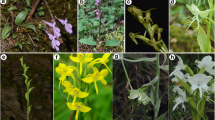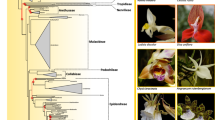Abstract
Cypripedioideae (Orchidaceae) have been the subject of numerous taxonomic treatments with conflicting interpretations of relationships among the five genera and the 150–170 species. We have produced nuclear ribosomal ITS nucleotide sequences for nearly 100 slipper orchid species and used parsimony analysis to investigate their relationships. Our results demonstrate that each genus, as currently circumscribed, is monophyletic (Mexipedium andSelenipedium being represented by a single taxon). LikerbcL data, ITS sequences placeMexipedium sister toPhragmipedium. Relationships at the sectional level inPaphiopedilum are largely as described byCribb. However, the division ofPaphiopedilum into subgg.Brachypetalum andPaphiopedilum is not supported; subg.Brachypetalum is paraphyletic to subg.Paphiopedilum. Phragmipedium species are divided into the same three major clades as in the taxonomic scheme ofMcCook. The plicate-leaved genera,Cypripedium andSelenipedium, are successive sister groups to the rest of the subfamily, confirming generally held opinions that they display plesiomorphic characters compared to the conduplicate-leaved genera. A survey of karyotypes in the context of the ITS tree reveals a general trend toward increased chromosome number, probably brought about by centric fission. These data also accord with a previously suggested biogeographic hypothesis of a widespread Northern Hemisphere distribution, followed by range fragmentation due to Miocene cooling.
Similar content being viewed by others
References
Albert, V. A., 1994: Cladistic relationships of the slipper orchids (Cypripedioideae:Orchidaceae) from congruent morphological and molecular data. — Lindleyana9: 115–132.
—, 1992:Mexipedium: a new genus of slipper orchid (Cypripedioideae:Orchidaceae). — Lindleyana7: 172–176.
—, 1994: Expansion of genusPaphiopedilum to include all conduplicate-leaved slipper orchids (Cypripedioideae:Orchidaceae). — Lindleyana9: 133–139.
Atwood, J. T. Jr., 1984: The relationships of the slipper orchids (subfamilyCypripedioideae, Orchidaceae). — Selbyana7: 129–147.
Baldwin, B. G., 1992: Phylogenetic utility of the internal transcribed spacers of nuclear ribosomal DNA in plants: an example from theCompositae. — Molec. Phylogenet. Evol.1: 3–16.
Bentham, G., Hooker, J. D., 1883: Genera plantarum3(2): 634–635. — London: Reeve.
Braem, G. J., 1988:Paphiopedilum: Eine Monographie aller Frauenschuh-Orchideen der asiatischen Tropen und Subtropen. — Hildesheim: Schmersow.
Brieger, F. G., 1971: Unterfamilie:Cypripedioideae. — InSchlechter, R., (Ed.): Die Orchideen, pp. 161–198. — Berlin, Hamburg: Parey.
Carpenter, J. M., 1988: Choosing among multiple equally parsimonious cladograms. — Cladistics4: 291–296.
Chase, M. W., Cameron, K. M., Hills, H. G., Jarrell, D., 1994: DNA sequences and phylogenetics of theOrchidaceae and other lilioid monocots. — InPridgeon, A. M., (Ed.): Proceedings of the 14th World Orchid Conference, pp. 61–73. — Edinburgh: HMSO.
Chase, M. W., Duvall, M. R., Hills, H. G., Conran, J. G., Cox, A. V., Eguiarte, L. E., Hartwell, J., Fay, M. F., Caddick, L. R., Cameron, K. M., Hoot, S., 1995: Molecular phylogenetics ofLilianae. — InRudall, P. J., Cribb, P. J., Cutler, D. F., Humphries, C. J., (Eds): Monocotyledons: systematics and evolution, pp. 217–225. — Richmond: Royal Botanic Gardens, Kew.
Chase, M. W., Hills, H. G., 1991: Silica gel: an ideal material for field preservation of leaf samples for DNA studies. — Taxon40: 215–220.
Chen, S. C., Tsi, Z. H., 1984: OnPaphiopedilum malipoense sp. nov. — an intermediate form betweenPaphiopedilum andCypripedium. — Acta Phytotax. Sin.22: 119–124.
Cox, A. V., 1995: The utility of 5S rDNA in phylogenetic reconstructions. — Ph.D. Thesis, University of Reading, England.
—, 1993: Comparison of plant telomere locations using a PCR-generated synthetic probe. — Ann. Bot.72: 239–247.
Cribb, P. J., 1987: The genusPaphiopedilum. — London: Collingridge.
Dahlgren, R. M. T., Clifford, H. T., Yeo, P. F., 1985: The families of monocotyledons: structure, evolution, and taxonomy. — Berlin, Heidelberg, New York: Springer.
Doyle, J. J., Doyle, J. L., 1987: A rapid DNA isolation procedure for small quantities of fresh leaf tissue. — Phytochem. Bull. Bot. Soc. Amer.19: 11–15.
Dressler, R. L., 1993: Phylogeny and classification of the orchid family. — Cambridge: Dioscorides Press.
—, 1995: Whence the orchids? — InRudall, P. J., Cribb, P. J., Cutler, D. F., Humphries, C. J., (Eds): Monocotyledons: systematics and evolution, pp. 217–225. — Richmond: Royal Botanic Gardens, Kew.
—, 1960: Classification and phylogeny in theOrchidaceae. — Ann. Missouri Bot. Gard.47: 25–68.
Farris, J. S., 1969: A successive approximations approach to character weighting. — Syst. Zool.18: 374–385.
—, 1996: Parsimony jackknifing outperforms neighbour joining. — Cladistics12: 99–124.
Felsenstein, J., 1985: Confidence limits on phylogenies: an approach using the bootstrap. — Evolution39: 783–791.
Fitch, W. M., 1971: Toward defining the course of evolution: minimum change for a specific tree topology. — Syst. Zool.20: 406–416.
Garay, L. A., 1979: The genusPhragmipedium. — Orchid Digest43 (July–Aug.): 133–148.
Hallier, H., 1897: ÜberPaphiopedilum amabile und die Hochgebirgsflora des Berges K'Lamm in West Borneo nebst einer Übersicht über die GattungPaphiopedilum. — Ann. Jard. Bot. Buitenzorg14: 18–52.
Karasawa, K., 1979: Karyomorphological studies inPaphiopedilum, Orchidaceae. — Bull. Hiroshima Bot. Gard.2: 1–149.
—, 1980: Karyomorphological studies inPhragmipedium, Orchidaceae. — Bull. Hiroshima Bot. Gard.3: 1–49.
—, 1986: Karyomorphological studies on nine taxa ofPaphiopedilum. — Bull. Hiroshima Bot. Gard.8: 23–42.
—, 1986: Karyomorphological studies onCypripedium in Japan and Formosa. — Bull. Hiroshima Bot. Gard.31: 1–22.
—, —, 1988: Karyomorphological studies on two species ofPaphiopedilum. — Bull. Hiroshima Bot. Gard.10: 1–6.
—, 1982: A revision of the genusPaphiopedilum (Orchidaceae). — Bull. Hiroshima Bot. Gard.5: 1–69.
—, 1980: C-banding study on centric fission in the chromosomes ofPaphiopedilum. — Cytologia45: 97–102.
—, —, 1981: A revision of chromosome numbers in some hybrids ofPaphiopedilum. — Bull. Hiroshima Bot. Gard.4: 1–8.
Kraenzlin, F., 1897: Orchidacearum et species plantarum. — Berlin: Mayer & Müller.
Lavin, M., Luckow, M., 1993: Origins and relationships of tropical North America in the context of the boreotropical hypothesis. — Amer. J. Bot.80: 1–14.
Lindley, J., 1840: Genera and species of orchidaceous plants. — London: Ridgway.
Linnaeus, C., 1753: Species plantarum. — Stockholm: Salvius.
McCook, L., 1989: Systematics ofPhragmipedium (Cypripedioideae:Orchidaceae). — Ph. D. Thesis, Cornell University, Ithaca, New York.
McDade, L. A., 1990: Hybrids and phylogenetic systematics. I. Patterns of character expression in hybrids and their implications for cladistic analysis. — Evolution44: 1685–1700.
—, 1992: Hybrids and phylogenetic systematics. II. The impact of hybrids on cladistic analysis. — Evolution46: 1329–1346.
Maddison, D. R., 1991: The discovery and importance of multiple islands of mostparsimonious trees. — Syst. Zool.40: 315–328.
Maddison, W. P., Maddison, D. R., 1992: MacClade: analysis of phylogeny and character evolution, version 3.0. — Sunderland, Massachusetts: Sinauer.
Pfitzer, E. H. H., 1886: Morphologische Studien über die Orchideenblüthe. — Heidelberg: Winter.
—, 1888: Die Orchideen. — InEngler, A., Prantl, K., (Eds): Die natürlichen Pflanzenfamilien2, pp. 52–96. — Leipzig: Engelmann.
—, 1894: Beiträge zur Systematik der Orchideen. — Bot. Jahrb. Syst.19: 1–42.
—, 1903:Orchidaceae — Pleonandrae. — InEngler, A. (Ed.): Das PflanzenreichIV 50, pp. 1–132. — Leipzig: Engelmann.
Rafinesque, C. S., 1836: Flora Telluriana4: 45–47. — Philadelphia: Pobasco.
Reichenbach, H. G., 1854: Xenia orchidacea1. — Leipzig: Brockhaus.
Rieseberg, L. H., 1990: Homoploid reticulate evolution inHelianthus (Asteraceae); Evidence from ribosomal genes. — Amer. J. Bot.78: 1218–1237.
Rolfe, R. A., 1896: TheCypripedium group. — Orchid Rev.4: 327–334, 363–367.
Rosso, S. W., 1966: The vegetative anatomy of theCypripedioideae (Orchidaceae). — J. Linn. Soc. Bot.59: 309–341.
Soto, M. A., Salazar, G. A., Hágsater, E., 1990:Phragmipedium xerophyticum, una nueva especie del sureste de México. — Orquídea (México)12: 1–10.
Stebbins, G. L., 1971: Chromosomal evolution in higher plants. — London: Arnold.
Stern, W. L., Cheadle, V. I., Thorsch, J., 1993: Apostasiads, systematic anatomy, and the origins ofOrchidaceae. — J. Linn. Soc. Bot.111: 411–455.
Swofford, D. L., 1993: PAUP: phylogenetic analysis using parsimony, version 3.1.1. — Champaign, Illinois: Illinois Natural History Survey.
Thompson, J. D., Higgins, D. G., Gibson, T. J., 1995: CLUSTAL W: improving the sensitivity of progressive multiple sequence alignment through sequence weighting, position, specific gap penalties and weight matrix choice. — Nucl. Acids Res.22: 4673–4680.
Tiffney, B. H., 1985a: Perspectives on the origin of the floristic similarity between eastern Asia and eastern North America. — J. Arnold Arbor.66: 73–94.
—, 1985b: The Eocene North Atlantic land bridge: its importance in Tertiary and modern phytogeography of the Northern Hemisphere. — J. Arnold Arbor.66: 243–273.
Wimber, D. E., 1993: The chromosome evolution for slipper orchids. — InPridgeon, A. M., (Ed.): Proceedings of the 14th World Orchid Conference, pp. 228–232. — Edinburgh: HMSO.
Wolfe, J. A., 1975: Some aspects of plant geography of the northern hemisphere during late Cretaceous and Tertiary. — Ann. Missouri Bot. Gard.62: 264–279.
Author information
Authors and Affiliations
Corresponding author
Rights and permissions
About this article
Cite this article
Cox, A.V., Pridgeon, A.M., Albert, V.A. et al. Phylogenetics of the slipper orchids (Cypripedioideae, Orchidaceae): Nuclear rDNA ITS sequences. Pl Syst Evol 208, 197–223 (1997). https://doi.org/10.1007/BF00985442
Received:
Revised:
Accepted:
Issue Date:
DOI: https://doi.org/10.1007/BF00985442




